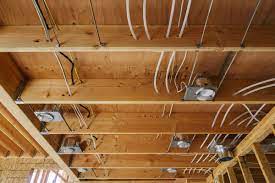What exactly is a Rewire in the Electrical System?
A house may have some or all of its electrical wiring replaced as part of an electrical rewire. This is done to preserve the safety and avoid harmful risks in the home, such as defective wiring. Especially in older buildings, such flaws, if left undiscovered, might result in structural damage or flames if they were to cause an accident.
Your property will be brought up to date to meet the requirements of today with the installation of new electrical wiring, which will increase your level of safety and may also provide you with extra electrical outlets located in more convenient locations.
Get To Know How to Rewire Your House
It is also possible to incorporate components such as up-to-date safety devices and fuse boards, which will safeguard the user from the dangers of electric shocks and fire.
The current electrical system should be one of your top priorities when considering a house makeover. Are the system’s capacity (measured in amps) and the state of the existing electrical wiring up to code?
The most expensive home renovation projects include replacing the plumbing, heating, and cooling systems and the electrical system. You must use a certified electrician for any significant electrical rewiring, who will, in turn, help you to know cost to rewire a house effectively.
In rare circumstances, you may be able to complete part of the electrical work yourself if you have the necessary documentation and a competent electrical inspector has validated your work. Before you start, you should verify your local construction codes.
Components of an electrical system
An electrical system in a home comprises a few essential parts. The system’s most crucial components are the primary circuit panel and service entry. Additional auxiliary circuit panels can be needed, depending on how complicated the wiring circuits are.
The current National Electrical Code advises a minimum 100 amp incoming electrical service. To accommodate the demands of contemporary electrical loads, your service panel should be updated to the minimum or greater amperage if it offers less.
Most newly constructed homes get 200 amp service wired. When it comes to grounding, outdated service panels frequently fall short, so an electrician should give it a full inspection if you plan to maintain yours.
Copper vs. Aluminum Wiring
Each circuit’s actual electrical wire, which runs through your house, might be copper or aluminum. Aluminum wire was utilized in certain older homes and some residences built in the 1970s and the first part of the 1980s.
Current building rules often prohibit aluminum wire. There are several causes for this. When heated, copper and aluminum both expand and contract. Contrary to copper, aluminum tends to lose some tightness with each cycle.
When it comes in touch with some metals, it may induce corrosion, making the connection more resistant. The primary issue with aluminum is the fire threat.
Aluminum can be made safe in several ways, but we shall discuss those in another post. For new construction or renovations, solid copper wire is the preferred material.
Although 12-gage wiring is somewhat more expensive and can carry more electrical current than 14-gage wiring, it is advised that you use it since it is safer and more energy-efficient. However, 14-gage wire is permitted for many circuits.
The wiring in a very ancient house will need to be entirely replaced with new copper wire if it contains fabric insulation or if the insulation is fragile and damaged. The wall covering must be removed from the studs to achieve this. It’s an enormous task.
A reliable electrical contractor should provide you with quotes. There are often highly few outlets in each room of older homes. Take the time to prepare for any new outlets you might need, including the wiring required. If you believe you have the necessary expertise, you can finish the rebuild yourself once the wiring is installed.
Changing Out Components
You won’t need to add any new circuits to the electrical system if you are content with the size of the system, the number of outlets, switches, and courses (make sure you are okay with the number and positions of the 240-volt outlets if any).
All that will be required is some system component updating and replacement. Before performing any electrical system checks, shut off the primary breaker switch. Your outlet boxes and switch boxes may be examined by removing the cover plates and pulling them back.
It most likely won’t need to be changed if it is in good condition and securely fastened to the wall and ceiling studs. Be aware that you will probably need to either add bracing to that outlet box or replace it with one built to accommodate a fan if you intend to install ceiling fans in the rooms.
If you still have, you must swap outdated two-prong outlets for grounded three-prong models. Replacing all the switches and outlets in the house is an excellent idea. According to most local rules, a GFCI (ground fault circuit interrupter) type outlet must be used in the bathroom, kitchen, and any other wet places adjacent to water.
When Is It Necessary to Replace the Wiring?
Rewiring your house is a wise decision for many different reasons. The following are some of the most prevalent explanations why:
- Rewiring should be done about every 20-25 years on average.
- Electrical checks were not passed.
- Insurance requirements.
- Ongoing issues include tripped circuit breakers (RCDs) or blown fuses regularly. Make sure to get your cicuit from trusted circuit breaker supplier and have it installed by experts.
- Electrical sockets make buzzing noises or become too hot to the touch.
- Lights or appliances that use electricity turn on and off, or electrical appliances turn on and off.
- The electricity and the appliances in one (or more) parts of the home cease working
- correctly.
- The wiring is not up to date and is covered with black rubber (over 50 years old).
Conclusion
A homeowner has a variety of options for estimating the size of the job involved in an electrical renovation. Planning your budget for a home electrical system upgrade can be significantly aided by knowing the size of the system you currently have, the state of your wiring and other components, and establishing a plan for any extra outlets and circuits you might need.





Be First to Comment